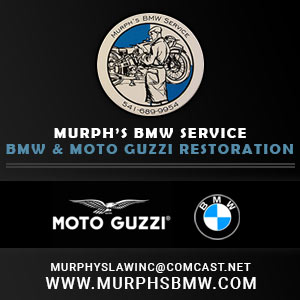Ignition switch woes 78 R80/7
I lost the key long ago to my original ignition switch. Locksmiths unable to fit a custom key. Bought a used one off EBay, had a crack in the plastic housing, finally quite working reliably (of course, on a trip.). Bought a new one from EME, a repro. The new one always had to be slammed all the way on, or it would switch off. Quite working reliably on my last trip, of course, now it is acting worse than the EBay one. Past return period. I don’t want to spend 150-200$ for another repro and have it fail. Universal ignition switches are available from like $20, can anyone recommend a universal, inexpensive ignition switch that will hook up easily and work well? I may try to pull apart the repro, but have little confidence I could fix it reliably. Thanks,
Josh
I looked and looked. No one else uses that 24mm barrel diameter. I finally ended up repairing an OEM switch. It's a complicated design, but very sturdy and built of materials that will withstand a rebuild.
The switch comes apart from the terminal end. FIRST mark the position of the plastic base to the housing on the outside with a scribed line. Photograph that. Then, bend the tabs back and pull out the plastic terminal board. Photograph the position of ALL the spring loaded contacts within. Then disassemble the remainder, and photograph the positions during disassembly.
Pack the lock section with waterproof grease. Pack the electrical section with a electrical dielectric grease. (You can probably use dielectric for both ends.) Use a hand file to flatten the internal side of the plastic back, and make all the contact points clean and flat. Put it all back together per the photos. You will not be able to fully bend the body back the way the factory had it, so filling those divots with epoxy may be called for. Before you do that make sure your switch makes the electrical contacts it needs to by ringing it out with an Ohm meter.
Several internal parts fit 2 ways, which is why you need the photos.
Welcome to my world !!
Owning an old Airhead is easy.
Keeping an old Airhead running great is the true test.
Thank-you for the step by step, I will give it a try.
Yes thanks for that as well. The internals of my switch are very sloppy and i need to jiggle the key to make things work properly.
Ray
Posted by: @15295Yes thanks for that as well. The internals of my switch are very sloppy and i need to jiggle the key to make things work properly.
Ray -
The contacts are spring loaded to push against the inside of the plastic terminal end cap. Most probably the terminals are either slightly burned after 40 years, or the springs have lost some of their "Umph!". Either way it's an easy fix.... as long as everything goes back in the way it came out !
Owning an old Airhead is easy.
Keeping an old Airhead running great is the true test.
So, I'll need new springs or can i stretch them out a bit? It is the springs, it's sloppy. And a nice dose of your dialectic grease. I use that on everything now. It brought back an old 60 tbird's radio, electric windows and fan motor.
- There are many reasons the switch could be feeling loose. You simply need to wait until you get inside. The terminals could have receded or worn way down, the crimps could be loose allowing the plastic back to back off, the springs could be sacked out, etc.
- Dielectric grease is different from the No-Ox-Id I often tout. It's a water repellant, but is absolutely non-conductive... basically a silicone grease.
Hope this helps.
Owning an old Airhead is easy.
Keeping an old Airhead running great is the true test.
Posted by: @15295I use(d) the no ox id. Thought dialectic grease was a generic term for it.
I think you'll be OK.
• "Dielectric grease" simply works by excluding water, but it does nothing to actively control or fight connector corrosion. Water causes about 95% of the issues with electrical connections, so if you have a new motorcycle, and the ignition must keep working... even in a thunderstorm... then it's a good choice. Bottom line is that most dielectric grease is merely thick, inert silicone grease which is excellent for simple prevention.
• The various brands of "No-Ox" exclude water AND fight oxidation on various types of electrical connections. When you have a 40yo motorcycle and the horn doesn't work, you really don't care if the first owner drove 8 hours in a thunder storm. You simply want the horn function restored. It's too late to do the "prevention", so you need a product that actively "re-establishes" the connection... and keeps it that way.
In truth, un-seating and then re-seating a connector will usually restore a connection, but there is no insurance it will remain that way. This is because, once corrosion starts it generally continues. Since no one really wants to re-visit the same issue over and over, then it makes the most sense to treat it once and be done. That's the difference in the 2 products, and why I tout the properties of the second.
Hope this helps.
Owning an old Airhead is easy.
Keeping an old Airhead running great is the true test.
Thanks for the explanation. No Ox Id works really well. It's brought back to life several old electrical products that I've acquired. I always clean the connections as well.
Posted by: @15295Thanks for the explanation. No Ox Id works really well. It's brought back to life several old electrical products that I've acquired. I always clean the connections as well.
It's the first thing I do with a new to me bike. (It's nothing short of a miracle on a British bike !) And every time I replace a voltage regulator, starter relay, or work on an instrument cluster... they don't get plugged back in until the connector or terminals are treated.
Ride safe !
Owning an old Airhead is easy.
Keeping an old Airhead running great is the true test.
- 27 Forums
- 1,952 Topics
- 11.1 K Posts
- 10 Online
- 11.9 K Members





